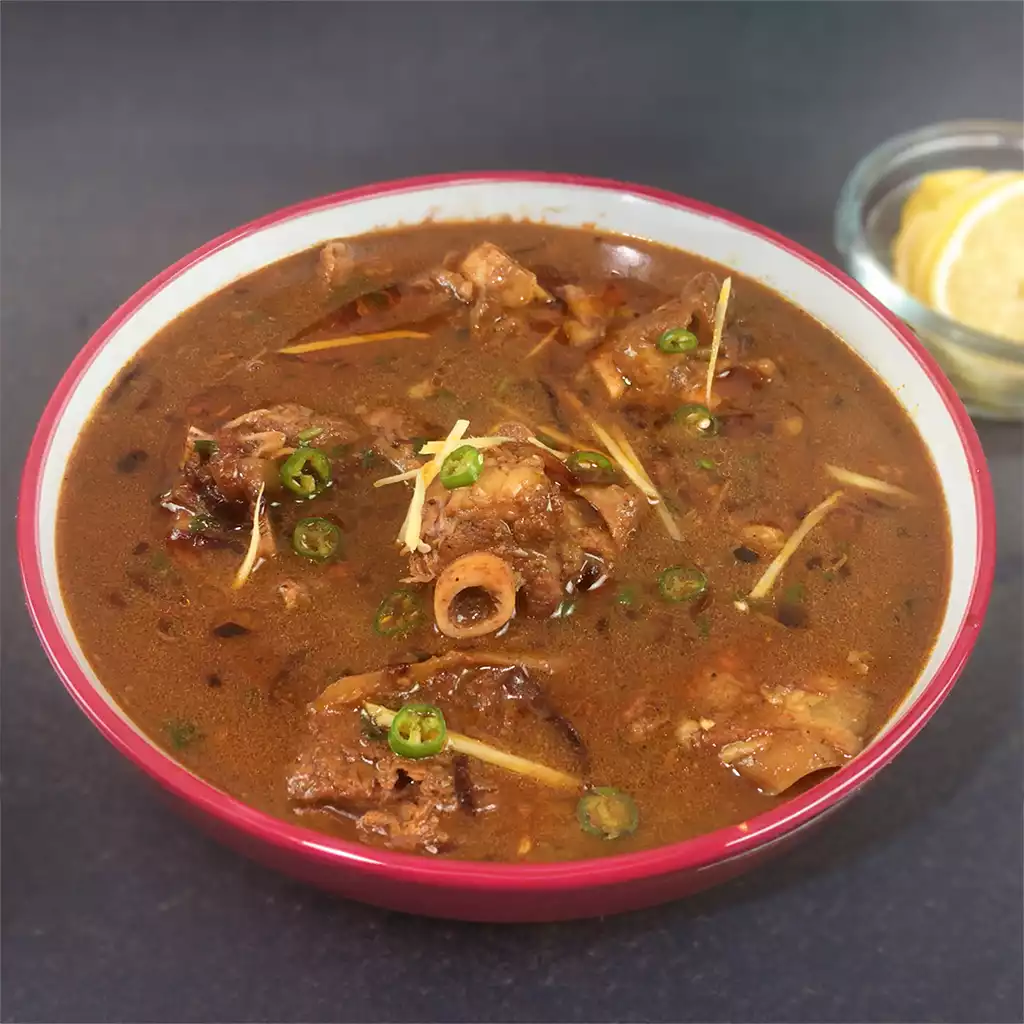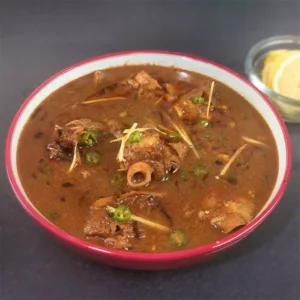
Mutton Nihari, a dish steeped in history and tradition, yet always ready to surprise your taste buds with its rich flavors and tender meat. Originating from the royal kitchens of the Mughal era, this recipe has stood the test of time, delighting generations with its hearty goodness.
While Nihari may sound exotic, fear not, for I’m here to guide you through each step of this culinary journey.
Despite its regal origins, this recipe doesn’t demand master chef skills. With a bit of patience and love for cooking, you can recreate the magic of Mutton Nihari right in your kitchen.
Prepare yourself to indulge in a dish that blends the warmth of spices with the succulence of slow-cooked meat. Are you ready to elevate your cooking game and savor the irresistible allure of Mutton Nihari?
Expert Tip: To achieve a velvety smooth gravy, make sure to cook the flour mixture thoroughly until it thickens and blends seamlessly with the Nihari. This will ensure a rich and luxurious texture that coats the meat beautifully.
Mutton or Lamb: Mutton brings a depth of flavor and tenderness that is essential for Mutton Nihari. Its rich taste enhances the overall experience, making each bite a savory delight.
Onions: These humble bulbs add a sweet and caramelized flavor to our Nihari, complementing the spices and meat perfectly. They melt into the gravy, adding a luscious texture and richness.
Oil: Acting as the base for our Nihari, oil helps in sautéing the aromatics and browning the meat, ensuring a robust flavor profile and succulent texture.
Ginger Paste and Garlic Paste: These two ingredients form the aromatic foundation of our dish, infusing it with their pungent and earthy flavors. They marry well with the spices, adding depth and complexity to the gravy.
Chilli Powder, Turmeric Powder, and Salt: These spices are the heart and soul of our Nihari, imbuing it with warmth, color, and a balanced seasoning. Together, they create a harmonious blend of flavors that tantalize the taste buds.
Wheat Flour: Used as a thickening agent, wheat flour helps to achieve the desired consistency of the Nihari gravy. It forms a smooth paste when mixed with water, adding body and richness to the dish.
Coriander, Ginger, and Green Chillies: These fresh garnishes add a burst of freshness and heat to our Nihari, elevating its flavor profile and enhancing its visual appeal. They provide a vibrant contrast to the rich and hearty gravy.
Nihari Masala: This special spice blend is the secret behind the distinctive flavor of Mutton Nihari. Made from a combination of aromatic spices like fennel seeds, cumin seeds, coriander seeds, peppercorns, cinnamon, cardamom, and cloves, it imparts a complex and tantalizing aroma to the dish.
Expert Tip: When grinding the spices for the Nihari masala, toast them lightly in a dry pan before grinding to enhance their aroma and flavor.
Experiment with different serving options to find your perfect combination and enjoy the sumptuous flavors of Mutton Nihari to the fullest.
Expert Tip: For best results, marinate the mutton with ginger paste and garlic paste for at least an hour before cooking. This helps to tenderize the meat and infuse it with flavor.
Mutton Nihari is a traditional Indian and Pakistani dish known for its rich and aromatic gravy, slow-cooked with tender mutton or lamb and a blend of spices. It is often enjoyed as a hearty meal, especially during special occasions or festive gatherings.
While Mutton Nihari does contain spices, the level of spiciness can be adjusted according to personal preference. You can control the heat by adjusting the amount of chili powder and green chilies used in the recipe.
Yes, Mutton Nihari can be made ahead of time and actually tastes even better the next day as the flavors have more time to develop. Simply store it in an airtight container in the refrigerator and reheat gently before serving.
Yes, you can substitute beef for mutton in this recipe if you prefer. Keep in mind that the cooking time may vary slightly depending on the cut of beef used, so adjust accordingly to ensure the meat is tender.
Yes, you can freeze leftover Mutton Nihari for future use. Allow it to cool completely, then transfer it to a freezer-safe container or resealable bag. When ready to enjoy, thaw overnight in the refrigerator and reheat gently on the stove or in the microwave until heated through.
Mutton Nihari is traditionally served with naan bread or steamed rice, along with fresh garnishes such as chopped coriander, julienned ginger, and sliced green chilies. You can also pair it with yogurt raita or pickled onions for added flavor and texture.
Here are some more recipes for you to enjoy! If you my recipes don’t forget to rate and leave a comment.
If you have any recipe suggestions, please do not hesitate to ask me. A great way to stay in contact with me is through Instagram, Facebook, Twitter and YouTube. Don’t forget to tag me @CookwithNabeela in your recipe photos!

Subscribe now to receive my latest recipes directly in your inbox. Stay up-to-date and never miss out!

I love to cook! I want to share with you my favourite, delicious family-friendly recipes. I want to inspire you to create fantastic food for your family every day.
Latest comments (20)
v
make it shorter
Hi,
Thank you for the recipe. There seems to be an error in the recipe card. For Nihari masala you have mentioned 1tbsp peppercorn and in video you have used 1tsp. Which one is correct? I think my Nihari became too spicy because of that.
Thank you for trying out the recipe and for pointing that out! I apologize for any confusion caused. I’ve updated the recipe card to reflect the correct amount of peppercorns. I hope your next batch turns out perfectly balanced.
Made this many times. Love the Indianing English in the the text, so sweet.
Glad to hear you’ve enjoyed it multiple times. If you have any variations or tips to share, feel free to let me know.
What do you serve besides bread with mutton nihari, as side dishes? Thank you
I recommend serving it with some fragrant steamed rice or simple chapati. Both options complement the rich flavors of the dish really well. 😊
When do you add the onions
Great recipe. Simple instructions and so delicious!
I added small doses of water during the cooking process to prevent the spices burning at the bottom of the pot.
A bit more salt and a dash of lemon juice to taste at the end. Thanks a lot for sharing.
This went down a treat at my household.
Thank you for trying out the recipe and sharing your experience! It’s wonderful to know that the dish was a hit with your household. If you have any more tips or feedback, feel free to share! 🙂
Is the 807 kcal in one serving?
This recipe has 677 per serving. Nihari does tend to have high calories and is not the healthiest curry 🙂
Thank you for this recipe! Came out delicious 🙂
Thanks for trying my Mutton Nihari recipe! So glad you enjoyed it 🙂
First time making Nihari. Recipe is great so far however my wheat flour doesn’t mix smoothly like yours in the video. Can I use cornflour? Please advise..
Thanks for trying out my recipe. It is best to use wheat flour. Try to add in small increments and then mix properly. A slurry is easily formed if mixed properly. Hope that helps ?